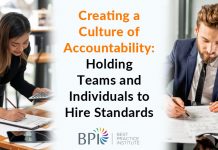Everyone is talking about employee engagement these days. But what exactly is employee engagement? Does it mean the same for everyone and why is it important? This is a topic we discussed at the BPI Senior Executive Board Meeting in August. The first question we looked at was, “Why are you concerned with engagement”? Understanding exactly what you are trying to solve for will help focus you on the appropriate approach to take when trying to understand and then improve engagement. For example, often times engagement levels are specifically tied to a turbulent time-period or a disruptive issue that is directly impacting your business. This is a current focused engagement issue and most likely something has already gone astray that resulted in a negative impact on your business which will likely lead you to focus on productivity or morale. On the other hand, if you are preparing for an upcoming event or a significant transition within the organization, you may find that your focus is on future engagement and what you can do now, to ensure desired engagement levels in the future, for example, focusing on retention.
Where to Start / Getting to the Facts
- Focus on solving the right problem – ask the right people
- Know your audience and determine where the results will be displayed/shared
- Determine the design that is appropriate for your company /circumstances and make sure your benchmarks are meaningful
- Determine how you will obtain and use the data and who is responsible acting on the results
- Ensure that you measure the success of your program and that your metrics are tied back to the problem you’re trying to solve
Focus on solving the right problem. You’ll start with an assumption and build around that topic.
Be sure to avoid not including enough people in the discussion around the topic. If you’re in the talent role, talk with the HR business partners and business leaders to confirm your focus.
Think about the audience. Will you be keeping the results to yourself and a small team? Will you decide later on how broadly you’ll be willing to share the results?
Ensure that you don’t over promise the extent to which you will be willing to share the data. Understand that the results themselves, don’t always paint a picture that accurately represents all the circumstances that go into a score. If you conduct a survey, you may need to conduct focus groups afterward, to confirm the meanings behind the scores and to verify that the data represents what you believe it to represent.
Designing and benchmarks. How will you obtain your engagement data? You will need to decide if you will construct a full (generally over 50 questions) survey or a shorter (pulse) survey, or in-person focus groups. These are the most common designs. Also, understanding where you stand relative to your benchmark is helpful. For example, you may be interested in an industry benchmark or a high performing company benchmark etc. It’s useful to see where you stand relative to your benchmarks, particularly on your highest and lowest scores.
Determine how you will obtain and use data. The way you obtain and use the data is very important.
Will you establish focus groups and speak with employees face to face? What type of questions would you ask? How would you arrange the sessions? These are very important questions that need to be addressed. Setting up and running Focus Groups can be a very valuable experience. We learned from the experience of Mike Rosenberg, Director of Learning, Leadership, and Development. Mike stated that “Focus groups are great because they allow you to get at information that people aren’t able or willing to give in an online survey. The recipe for success is to focus on asking a few powerful questions that get at the core of what you want to know, and having a facilitator who is good at getting people to open up.”
Another way to obtain information is through a survey. Will you conduct an anonymous survey where people “self-identify” or will you pre-code to ensure data rolls up more accurately?
We have found that in matrix organizations, employees sometimes align with their business line, rather than with their functions, and if they self-identify, that can cause problems with your results. If you pre-code, it’s more likely that employees will be wondering if you can identify them by their demographics. So, communicate around this topic carefully- be clear and transparent. And finally, who is responsible for acting on the results? If you as the HR leader expect managers to be responsible for taking action based on results- you will need to have the business drive accountability throughout each group.
At the end of some period, 9 – 12 months, for example, review the process from beginning to current phase and evaluate
- Did we target the right issues? Are we getting good information to help us address concerns?
- Did we construct the appropriate design? Did our employee respond to our request for input?
- Did we communicate openly & honestly and set expectations and hold people accountable?
- Are employees expressing their views and providing valuable input and ideas to keep them engaged?
- Are you able to reduce concerns and effectively continue meaningful conversations with broad sets of employees who are willing to come to the table to make their company better?
Engagement will continue to be important in the workplace and will most likely take on new and different nuances as we move from more traditional communication styles to more digitally based communication. Staying close to your employees and encouraging them to express their ideas, views, like and dislikes, will become even more important as the workforce, in general, tends to speak less and text more. You never want to lose touch with your employees. You need to stay in constant contact with them and build an environment that enables them to feel included, and able to share varying points of view. The recipe for good engagement is based on a fundamental trust, respect and good communication skills…. not unlike a generally good relationship. If your organization establishes that level of trust and openness, you’ll most likely find that when difficulties arise or stressful conditions are presented by external forces or even internal forces, they tend to be easier to address and overcome.










